Workshop Manual

Volume IA - Engine, 16 valves
DR. ING. h. c. F. PORSCHE Aktiengesellschaft
As webpage by http://www.uriarte.dk/porsche944
12.3.2018
|
Workshop Manual  Volume IA - Engine, 16 valves DR. ING. h. c. F. PORSCHE Aktiengesellschaft As webpage by http://www.uriarte.dk/porsche944 12.3.2018 |
|
|
TYPE 944 S (16-VALVE ENGINES) - '87 MODELS ONWARD 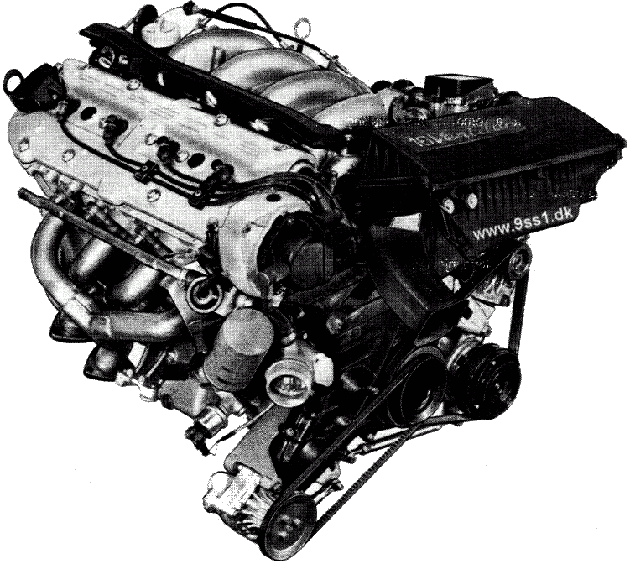
|
TECHNICAL DATA (Adjustment specifications and wear data are stated in the appropriate Repair Groups) Note: US values are stated in parentheses DRIVE UNIT
|
|
|
|
|
|||||||||||||||||
|
|||||||||||||||
|
||||||||||||||||
Technical data - Type 944 52 - Model 89 (Values for adjustment and wear are to be found in the respective repair groups) Notes: USA values are given in brackets Drive unit
|
DME control unit error diagnosis DME control unit error diagnosis 944 S as from 88 model As from model year 88, the DME control unit 944 S is capable of a self-diagnosis. That is to say, the control unit is capable of detecting, storing and displaying system errors. The con- trol unit capable of diagnosis is identified by an altered part number. A specially developed diagnostic tester (special tool No. 9268) is then used to read out the error memory and to test specific components and control sig- nals af the fuel and ignition system. 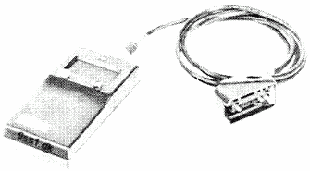
Important: Before diagnosis, the battery or the connector of the DME control unit must not be disconnected as otherwise the error memory will be erased.
|
Display 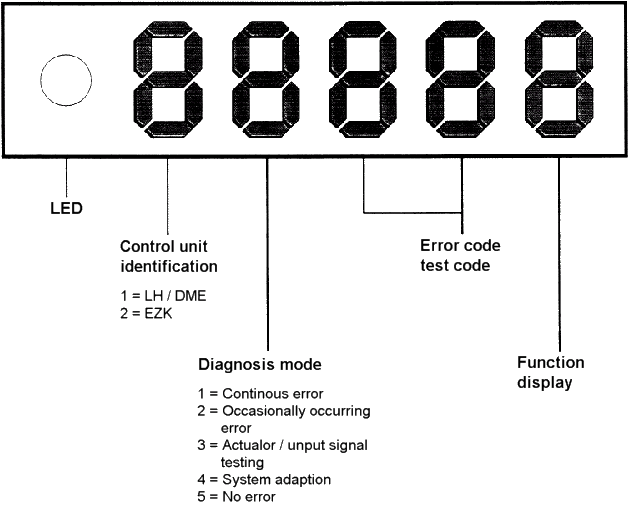
|
|
|
|
Press the green key until the clear symbol ap- pears on the function display. The following display must then appear. Display: 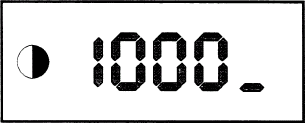 This now terminates diagnosis of the DME control unit. If one or several errors (up to 5) has/have been displayed, the error memory must be reset; see chapter (Resetting the error memory).
|
|
|
|
|
Press the green key until the clear symbol appears. Display:  End of the actuator and input signal function checks.
|
|
|
|
|
|
|
|
|
|
|
|
|
|
|
|
|
|
Error code - List
A digit 2 (e.g. 1211) may appear in the second error code digit position to indicate "sporadic errors", i.e. an occasionally occurring error. This does not apply to error codes 1000 and 1500.
|
|
|
Operating conditions for start of diagnosis
Webdesign from www.9ss1.dk/porsche944
|
Operating instructions for System Tester 9288 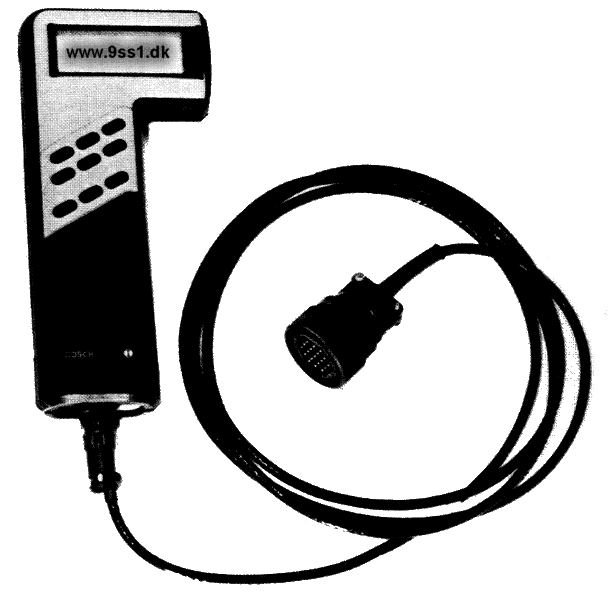
|
|
|
|
|
|
|
|
Tightening torques for engine (16-valve)
|
Tolerances and wear limits Engine M 44.40/41
|
Tolerances and wear limits Engine M 44.40/41
|
Tolerances and wear limits Engine M 44.40/41
|
REMOVING AND INSTALlING ENGINE (16-VALVE ENGINES) TOOLS 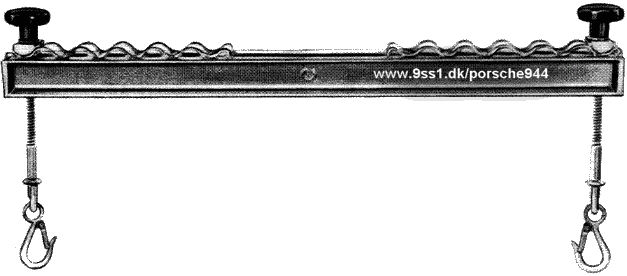
Note: If necessary, use a commercially available carabiner (load-bearing capacity 650 kg) to connect engine suspension beam to workshop crane.
|
REMOVING AND INSTALLING ENGINE (MANUAL TRANSMISSION) Remove by lowering engine from car. The bell housing remains attached to the engine.
|
|
12. Remove engine underguard.
|
|
|
|
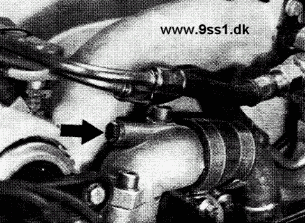
|
PISTONS. '87 MODELS ONWARD
|
Checking pistons and cylinder bores Motortype M 44.40
Note It recommended that the stocks of the relevant tolerance group are checked befare machining the cylinders. If necessary, hone to the piston size available. In some cases, certain tolerance groups may be in short supply.
|
Pistons from Model 89 onwards
Checking pistons and cylinder bore Engine type M 44.41 (3.0 l)
It is recommended that the stocks of the relevant tolerance group are checked before machining the cylinders. If necessary, hone to the piston size available. In some cases, certain tolerance groups may be in short supply.
|
This page are missing or blank in the book !
|
Assemble cover of centrifugal oil compartment in upper crankcase section. Notes on installation Model 89 onward, Engine type M 44.41 (3.0 l) Note Under normal conditions. it is not necessary to remove the cover when overhauling an engine. If the cover is removed, however, the bolt area must be heated with a hot-air blower under all circumstances. Apply Loctite 270 to hexagon head screws. Observe coding on the cover. 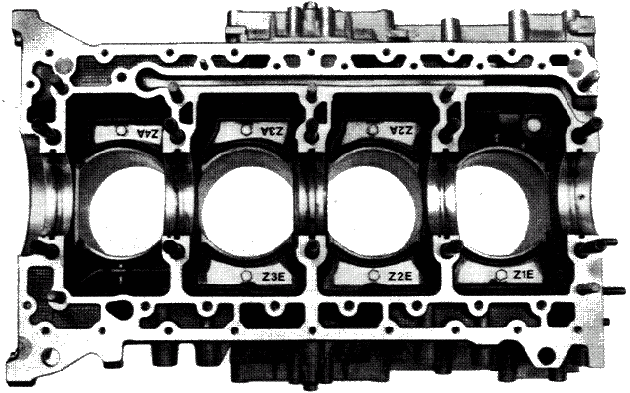
|
|
This page are missing or blank in the book !
|
This page are missing or blank in the book !
|
Adjusting with dial gages
|
|
Checking or adjusting camshaft setting for Model 89 onward Engine type M 44.41 (3.0 l) Note The timing has changed with installation of new camshafts for engine type M 44.41 (3.0 l) for Model 89 onward. Setting Inlet valve cylinder 1 Testing and adjusting value 0.75 +- 0.1 mm The camshaft is adjusted according to the same procedure as described on Page 15 - 102.
|
Applying the TDC mark on the camshaft sprocket Engine type M 44.40 / 41 (3.0 l) Note Camshaft sprockets available from the spare parts department do not have a TDC mark. This TDC mark is applied after the camshaft timing has been set on the new engine.
|
TOOLS - REMOVING AND INSTALLING CAMSHAFTS AND CYLINDER HEAD, DEGREES-OF-TURN METHOD OF TORQUING (16-VALVE ENGINES)  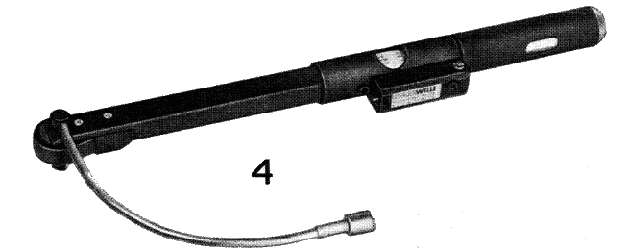
|
REMOVING AND INSTALLING CAMSHAFTS AND CYLINDER HEAD Removing:
|
|
|
|
Installing and tightening the cylinder head
|
|
|
Installing Camshaft Seal
|
|
REMOVING AND INSTALLING CHAIN TENSIONER Removing
|
This page are missing or blank in the book !
|
TOOLS - CYLINDER HEAD (16-VALVE ENGINES) 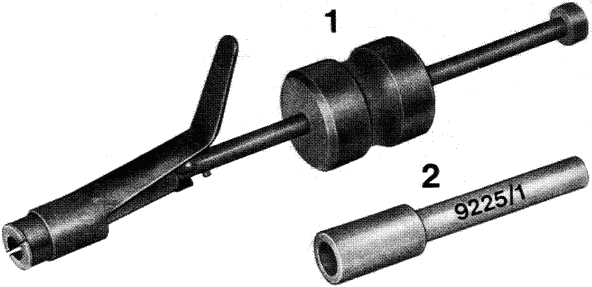 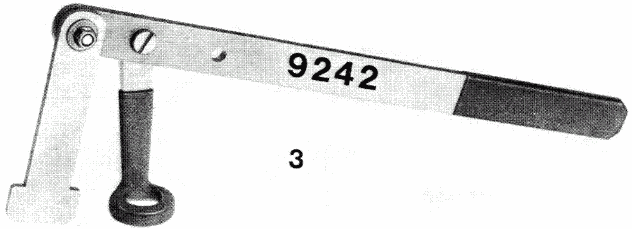
|
DISASSEMBLING AND ASSEMBLING CYLINDER HEAD (16-VALVE ENGINES) 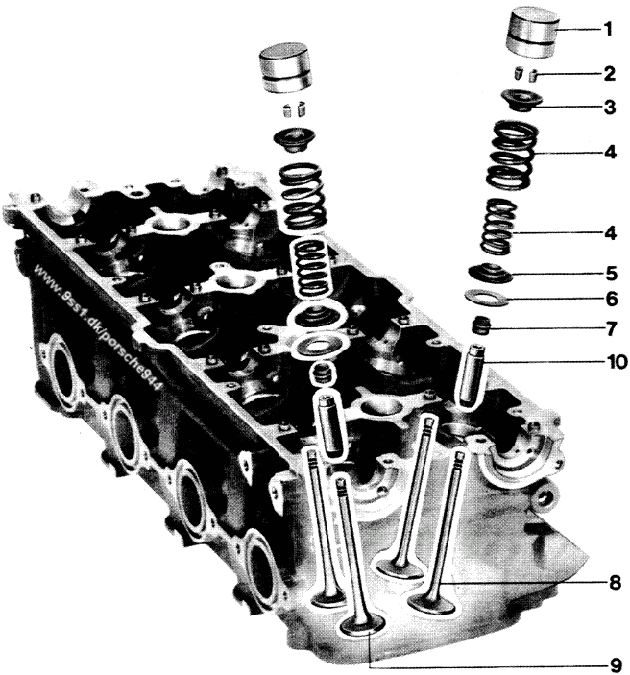
|
|
|||||||||||||||||||
Cylinder Head (16 Valves) Removing and installing valve springs Tools 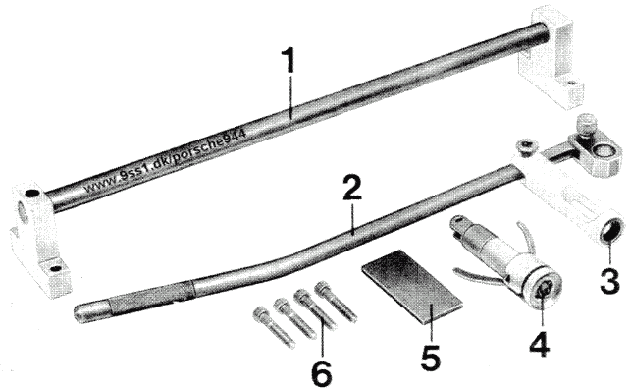
Note If the cylinder head is installed, the lever arm must be angled more accutely.
|
|
Remachining cylinder-head maling face Checking cylinder head for distortion
|
NOTES ON ASSEMBLY
|
INSTALLING VALVE STEM SEAL Note:
|
|
|
Replacing valve guides Tools 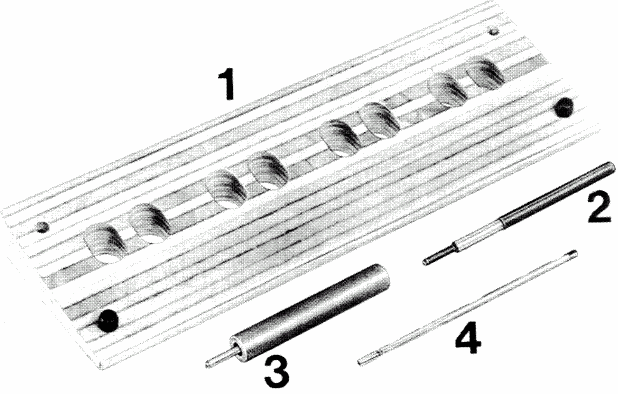
|
Drawing Plunger to press out the valve guide 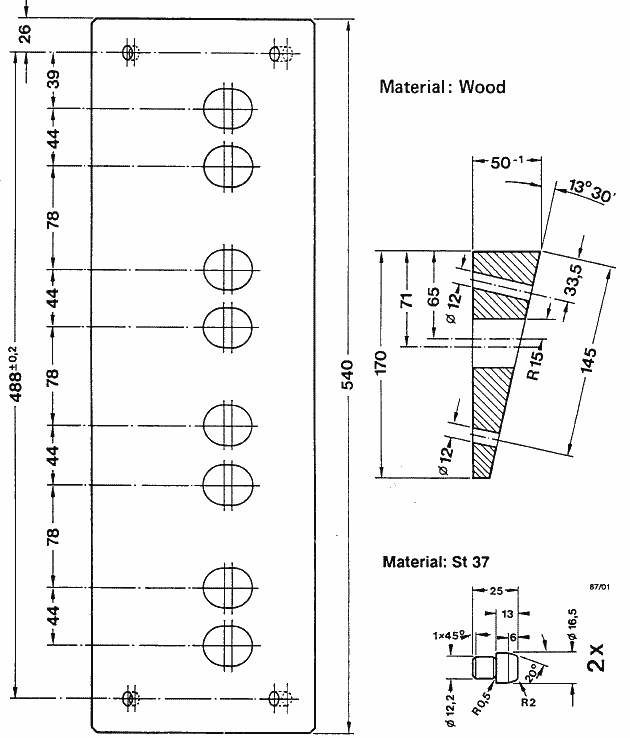
|
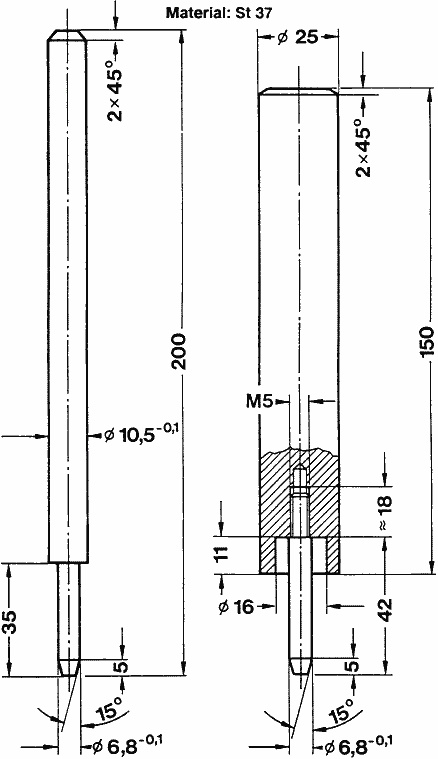
|
|
Proceed as follows: The valve guides must always be reamed with "petroleum" lubricant Withdraw the reamer regularly to remove chips. Then finish-ream the boreagain with a dry reamer. 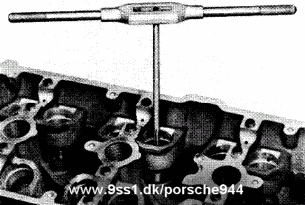
|
Checking the valve seat wear limit
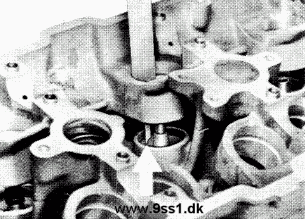
|
|
|
Checking and adjusting installation length of valve springs Valve springs, Model 87 onward Engine type M 44.40 Note
|
|
CHANGING ENGINE OIL AND ENGINE OIL FILTER (16-VALVE ENGINES) Preconditioned:
|
Removing and installing the pressure reducing valve Engine type M44.40 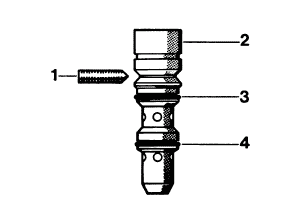
|
MIXING TABLE FOR COOLANT (Average values)
CHECKING HEATING AND COOLING SYSTEM FOR LEAKS (16-VALVE ENGINES)
|
|
|
CHECKING DELIVERY RATE OF FUEL PUMP
|
FUEL SYSTEM LINE ROUTING (16-VALVE ENGINES) '87 MODELS ONWARD ENGINE TYPE M 44.40 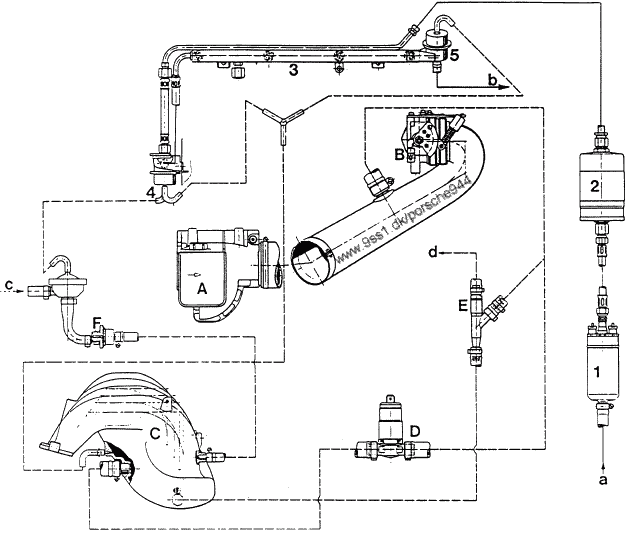
|
|
|
Testing and adjusting specifications Model 87 onward Engine type M 44.40/41 (3.0 I)
Note Carry out working procedure checking delivery rate of fuel pump and checking fuel pressure as described an Pages 20 - 102 and 24 - 103 respectively. Tightening torque for cap nut 12 Nm.
|
CHECKING FUEL PRESSURE TOOLS 
|
CHECKING FUEL PRESSURE
|
|
Checking idle speed and CO without catalytic converter
|
Replacing air filter insert Model 89 onward Engine type M 44.41 (3.0 l)
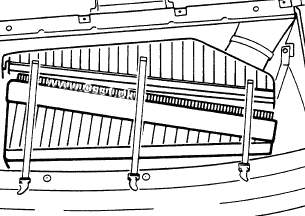
|
|
CHECKING TIGHTNESS OF EXHAUST SYSTEM FLANGES (16-VALVE ENGINES)
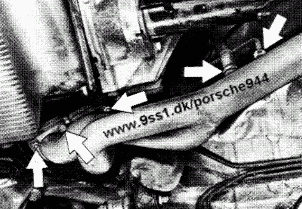
Tightening torques of nuts and bolts:
|
|
EQUIPMENT TABlE Ignition Coil
Distributor (Cap)
Spark plugs
Ignition trigger box
|
DME control unit
Hall probe for knock sensors
Knock sensor
|
DME CONTROL UNIT CODING, 944 S, '87 MODELS ONWARD
|
REPLACING SPARK PLUGS, 944 S
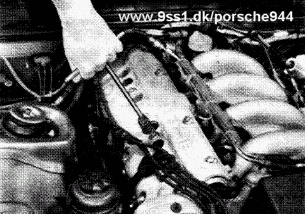 Tightening torque: 25 - 30 Nm (18 - 22 ftlb).
|
Equipment tabte 89 models onward Engine type M 44.41 (3.0 l) Ignition Coll
Distributor (Cap)
Spark plugs
Ignition trigger box
|
DME Control unit
Hall probe for knock sensors
Knock sensor
|
Coding - DEE control unit 944 S 2, Model 89 onwards
|
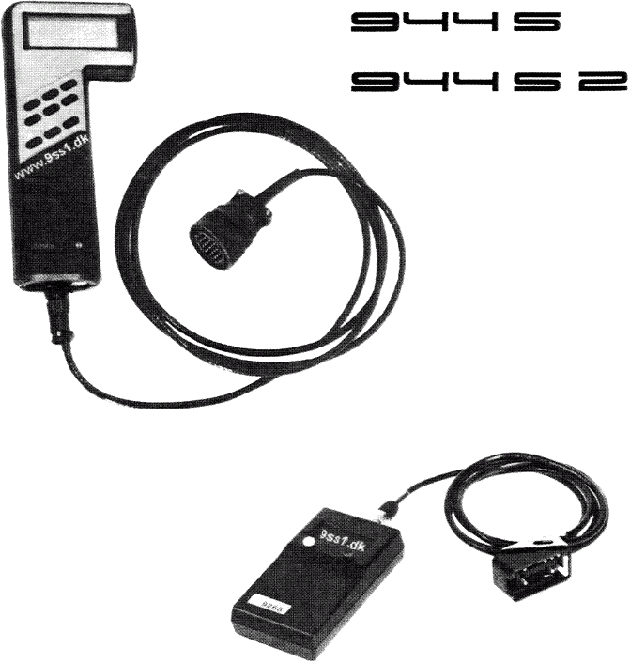
|
|
Precautions Greater demands of modern engines on the ignition systems and a desire for freedom from maintenance had led to the introduction of electronic ignition systems in standard production some time ago already. Normally the ignition power of electronic systems (almost all makes) will be greater than that of conventional systems and evan greater power can be expected in the future. This places electronic ignition systems in a power range, where touching current carrying parts or terminats could be dangerous to lite (both primary and secondary circuits). In conjunction with this matter we must point out that there must always be conformance with safety regulations and legislation of a pertinent country when working on or testing ignition systems. The ignition (ignition or source of power) must always be switched off when working on the ignition system. Sample Jobs:
The above mentioned dangerous voltage will be present in the entire system should it be necessary to switch on the ignition for ignition tests or engine adjustments. Consequently there is not onty danger on the various components of an ignition system (such as, for example, distributor, ignition coil, control units, ignition tackle), but also on wire harnesses, plug connections and testers.
|
Important Vehicle Information
|
|
Diagnosable DME Control Unit Self-diagnosis with a fault memory, with which it is possible to detect and store certain injection. ignition and knock regulating system faults, is integrated in the DME control unit of 944 S cars beginning with 1988 models. The DME control unit has a permanent positive connection to prevent cancellation of detected and stored faults by turning off the ignition. Detected faults remain stored in the memory for at least 50 engine starts (exception: idle speed switch interruption faults). Important! If the DME control unit plug or battery is disconnected, the fault memory and system adaptation will be cancelled. Tester Connections: A 12-pin plug, which leads out of the DME wire harness in the passenger's footwell to the right above the DME control unit, is provided for diagnosing in cars since 1988 models. 9268 Flashing Code Testers can be connected on this plug. A 19-pin plug replaces the 12-pin plug beginning with 1990 (L) models. Either a 9288 System Tester or the Flashing Code Tester (via adapter leads 9268/2) can be connected on this plug. Operation of the testers is explained in the instructions supplied with the testers. Note: A pertinent test point is supplemented by a corresponding fault flashing code of Tester 9268. Example: Test Point 2 = idle speed contact (1-12) Second digit display: "1" fault exists "2" fault does not exist The following actual engine data can be read direct in the "actual value" menu with a 9288 System Tester beginning with the version 2.0 tester module status.
|
This DME 944 S Diagnosing/Troubleshooting Plan is based on the contents of the fault memory. Paths not included in self-diagnosis can be diagnosed with conventional equipment (Test Points 17-25. see Fault List). Troubleshooting requires that the person performing the tests
Important! A fault text in the display (Fault List and Flashing Code) does not always indicate a fault in the pertinent component, but could also concern the corresponding control unit or connecting leads (paths) between the component and control unit. Troubleshooting on a running engine in the form of disconnection of plugs, etc. must not be carried out prior to reading the fault memory, since such action could be stored as faults in the fault memory. 9288 System Tester Information Displayed in Tester Fault does not exist, this could mean:
Signal Not Plausible: Signal of the monitored component does not fit in the tolerance range of the value calculated in the control unit.
|
This page are missing or blank in the book !
|
This page are missing or blank in the book !
|
|
|
|
|
|
|
|
|
|
|
|
|
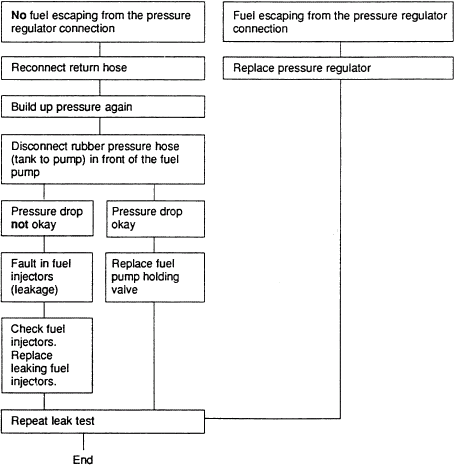
|
|
|
|
|
|
|
|
|
Adjusting value: 0.5 - 1.5 % CO at 840 +- 40 rpm and ignition timing of 10° +- 3° before TDC. Adapt the system after adjusting the CO level. An adapter plug (911.612.422.8) must be con- nected on the oxygen sensor connecting lead of cars without a catalytic converter, in order to avoid diffusion (see wiring diagram). c) Idle speed CO of cars with catalytic converter In addition to adaptation of the idle speed there is also adaptation of the idle speed CO level in these cars, so that it is only necessary to check the actual state in such cars. Requirements:
Test value: 0.4 - 1.2 % CO at 840 +- 40 rpm and ignition timing of 10° +- 3° before TOC. Afterwards the engine must be run at least 10 minutes after disconnection of the control unit plug or disconnection of the battery, before it will be possible to recheck these values. In addition, the system must be adapted.
|
Coding of Control Unit - 944 S Pertinent curve families are integrated in the DME control unit, in order to be able to comply with the legislation of different countries. They can be read direct in the "actual value" menu with a 9288 System Tester.
One each 2-pin and 3-pin plug, which are bridged differently depending on the country version, lead out of the DME wire harness to call these curve families.
|
Coding af Control Unit - 944 S 2
As from model year '91, the code for California and Japan is being deleted (identical worldwide).
|
Check-Engine Lamp (Malfunction Indicator Light M.I.L) As from model year '91, Califomian legislation prescribes a waming lamp which lights up if a part relevant to the exhaust gas fails. As a function check of the warning lamp, it lights up when the ignition is switched on and goes out once the engine is running when this is started without depressing the accelerator. The waming lamp has a flashing code to indicate a defective fault path. To trigger off the flashing code, fully depress the accelerator pedal with the engine off and the ignition on for 3 seconds until the Malfunction Indicator Lamp flashes. Then remove foot from accelerator. If no fault is recorded, i.e. no warning came from the indicator light, there appears the flashing code
If the waming light did indicate a warning, i.e. there is a fault, there appears a flashing code, e.g. 
The flashing code is listed in the Diagnosing/Troubleshooting plan on page D 24/28-7. The fault can also be read direct using System Tester 9288. After a repair the fault memory must be erased using the System Tester.
|